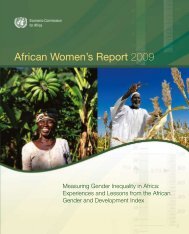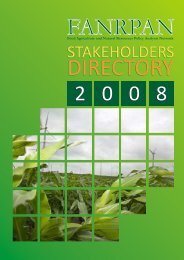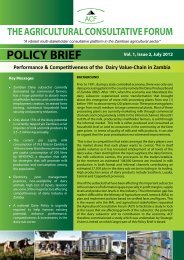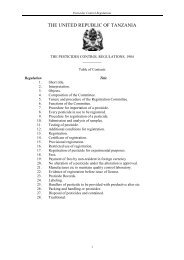Community-driven development decision tools for rural - IFAD
Community-driven development decision tools for rural - IFAD
Community-driven development decision tools for rural - IFAD
- No tags were found...
Create successful ePaper yourself
Turn your PDF publications into a flip-book with our unique Google optimized e-Paper software.
What is CDD?A definition of community-<strong>driven</strong> <strong>development</strong> (CDD) that reflects <strong>IFAD</strong>’s <strong>rural</strong> povertyalleviation objectives emerged from a workshop organized by <strong>IFAD</strong>’s Western and Central AfricanDivision (the Division) in the spring of 2004. It is presented in Box 1.CDD appreciates• the role that community-based organizations (CBOs) play in <strong>decision</strong>s about the economicand social <strong>development</strong> processes that directly affect the livelihood of their members;• the <strong>development</strong> of a culture within public administration that views communities assubjects of change and <strong>development</strong> partners in their own right, rather than as merereceivers of the benefits of public expenditure.According to this definition, CDD refers more to the way a policy or a project is designed andimplemented than to the content of a policy or to the components of an investment projector programme.Definition of a communityCDD deals with communities, but what is a community? It is important <strong>for</strong> <strong>IFAD</strong> to work with apragmatic concept of the <strong>rural</strong> community as a social reality of operational significance, whichcan be easily identified in practice. A version of such a pragmatic concept is shown in Box 2.CDD objectivesThe overall objective of CDD <strong>for</strong> <strong>IFAD</strong> is to enable <strong>rural</strong> poor people to overcome povertysustainably, more equitably and with more efficient use of resources. This may be achieved by• establishing an enabling institutional environment <strong>for</strong> the emergence of dynamiccommunity organizations;• developing community-level <strong>rural</strong> infrastructure;• fostering the local economy at the community level;• diversifying the sources of external support <strong>for</strong> CBOs.The importance of the institutional environment and CBOsEmerging, robust CBOs are important <strong>for</strong> growth at the community level. CDD is concernedwith the enabling instruments and mechanisms that encourage CBOs to emerge, operate, growand establish effective and sustainable linkages with the public administration, civil societyand commercial sector. In particular, CDD aims to clarify the authority, autonomy,responsibilities and accountability of the CBOs, their higher-level partnerships and thedifferent levels of public administration.Box 1Definition of CDDCDD is a way to design and implement<strong>development</strong> policy and projects thatfacilitates access to social human andphysical capital assets <strong>for</strong> the <strong>rural</strong> poor bycreating the conditions <strong>for</strong>• trans<strong>for</strong>ming <strong>rural</strong> <strong>development</strong> agentsfrom top-down planners into client-orientedservice providers;• empowering <strong>rural</strong> communities to takeinitiative <strong>for</strong> their own socio-economic<strong>development</strong> (i.e. building oncommunity assets);• enabling community-level organizations –especially those of the <strong>rural</strong> poor – to playa role in designing and implementingpolicies and programmes that affecttheir livelihoods;• enhancing the impact of publicexpenditure on the local economy at thecommunity level.10
















